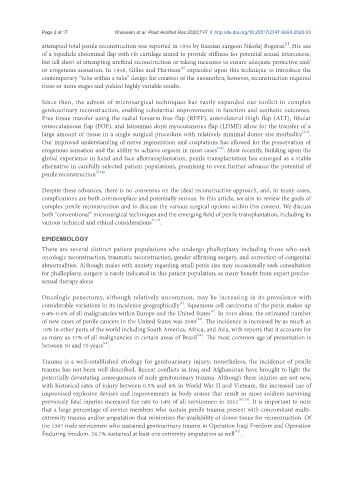Page 531 - Read Online
P. 531
Page 2 of 17 Khavanin et al. Plast Aesthet Res 2020;7:47 I http://dx.doi.org/10.20517/2347-9264.2020.63
[1]
attempted total penile reconstruction was reported in 1936 by Russian surgeon Nikolaj Bogoraz . His use
of a bipedicle abdominal flap with rib cartilage aimed to provide stiffness for potential sexual intercourse,
but fell short of attempting urethral reconstruction or taking measures to ensure adequate protective and/
[2]
or erogenous sensation. In 1948, Gilles and Harrison expanded upon this technique to introduce the
contemporary “tube within a tube” design for creation of the neourethra; however, reconstruction required
three or more stages and yielded highly variable results.
Since then, the advent of microsurgical techniques has vastly expanded our toolkit in complex
genitourinary reconstruction, enabling substantial improvements in function and aesthetic outcomes.
Free tissue transfer using the radial forearm free flap (RFFF), anterolateral thigh flap (ALT), fibular
osteocutaneous flap (FOF), and latissimus dorsi myocutaneous flap (LDMF) allow for the transfer of a
[3,4]
large amount of tissue in a single surgical procedure with relatively minimal donor site morbidity .
Our improved understanding of nerve regeneration and coaptations has allowed for the preservation of
erogenous sensation and the ability to achieve orgasm in most cases . Most recently, building upon the
[5,6]
global experience in hand and face allotransplantation, penile transplantation has emerged as a viable
alternative in carefully selected patient populations, promising to even further advance the potential of
penile reconstruction [7-11] .
Despite these advances, there is no consensus on the ideal reconstructive approach, and, in many cases,
complications are both commonplace and potentially serious. In this article, we aim to review the goals of
complex penile reconstruction and to discuss the various surgical options within this context. We discuss
both “conventional” microsurgical techniques and the emerging field of penile transplantation, including its
various technical and ethical considerations [7-11] .
EPIDEMIOLOGY
There are several distinct patient populations who undergo phalloplasty including those who seek
oncologic reconstruction, traumatic reconstruction, gender affirming surgery, and correction of congenital
abnormalities. Although males with anxiety regarding small penis size may occasionally seek consultation
for phalloplasty, surgery is rarely indicated in this patient population, as many benefit from expert psycho-
sexual therapy alone.
Oncologic penectomy, although relatively uncommon, may be increasing in its prevalence with
[3]
considerable variations in its incidence geographically . Squamous cell carcinoma of the penis makes up
[3]
0.4%-0.6% of all malignancies within Europe and the United States . In 2019 alone, the estimated number
[12]
of new cases of penile cancers in the United States was 2080 . The incidence is increased by as much as
10% in other parts of the world including South America, Africa, and Asia, with reports that it accounts for
[13]
as many as 17% of all malignancies in certain areas of Brazil . The most common age of presentation is
[14]
between 50 and 70 years .
Trauma is a well-established etiology for genitourinary injury; nonetheless, the incidence of penile
trauma has not been well described. Recent conflicts in Iraq and Afghanistan have brought to light the
potentially devastating consequences of male genitourinary trauma. Although these injuries are not new,
with historical rates of injury between 0.5% and 8% in World War II and Vietnam, the increased use of
improvised explosive devises and improvements in body armor that result in more soldiers surviving
previously fatal injuries increased the rate to 14% of all servicemen in 2011 [15,16] . It is important to note
that a large percentage of service members who sustain penile trauma present with concomitant multi-
extremity trauma and/or amputation that minimizes the availability of donor tissue for reconstruction. Of
the 1367 male servicemen who sustained genitourinary trauma in Operation Iraqi Freedom and Operation
Enduring freedom, 28.7% sustained at least one extremity amputation as well .
[17]

